
Vandenberg Air Force Base Launches
|
(Download a higher resolution picture by clicking on any
picture below.) 
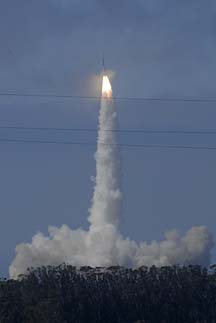 A Delta-II booster launched the Worldview 2 satellite from SLC-2 at Vandenberg Air Force Base at 11:51 AM on Thursday, October 8.
A Delta-II booster launched the Worldview 2 satellite from SLC-2 at Vandenberg Air Force Base at 11:51 AM on Thursday, October 8.
These are the launches illustrated on the page below. Click on a link to go directly to that launch.
Delta-II STSS-RTRR Launch, May 5, 2009
Taurus/Orbiting Carbon Observatory Launch Attempt, February 24, 2009
Delta II/COSMO Skymed launch, October 24, 2008
Target Launch Vehicle launch, September 24, 2008
Delta-II/GeoEye 1 launch, September 6, 2008.
Delta II/Jason 2 launch, June 20, 2008.
Delta-II/COSMO-SkyMed mission, December 8, 2007.
Delta-II/Worldview-1 launch, September 18, 2007.
Delta-II/COSMO-SkyMed launch, June 7, 2007
Delta II/NRO satellite Launch, December 14, 2006
Delta-IV/DMSP F17 launch from Vandenberg AFB, November 4, 2006
Delta-IV launch, June 27, 2006
Minuteman III launch, June 14, 2006
Delta II Launch, April 28, 2006
Minuteman III launch, February 16, 2006
The last Lockheed-Martin Titan IVB launch, October 19, 2005
Minotaur/Streak launch, September 22, 2005
Minuteman III, September 14, 2005
Minuteman III, September 7, 2005
Minuteman III, August 25, 2005
Delta-II/NOAA-18, May 20, 2005
Minuteman III, September 15, 2004
Peacekeeper Missile, July 21, 2004
Delta-II/Gravity probe-B, April 20, 2004
Atlas IIAS, National Reconnaissance Office payload, December 2, 2003
Minuteman III, September 10, 2003
Orbital Sciences Exoatmospheric Kill Vehicle, August 16, 2003
Pegasus XL/SCISat, August 12, 2003
Titan II/Coriolis, January 6, 2003
Minuteman II, October 14, 2002
Delta II/Iridium, February 11, 2002
Orbital Sciences L-1011 Stargazer departs with Pegasus XL/HESSI, February 1, 2002
Delta II/Jason and TIMED, December 7, 2001
Delta II/Digital Globe Quickbird II, October 18, 2001
Delta II/Earth Observing 1 and SAC-C, November 21, 2000
Minuteman II Launch, January 18, 2000
Atlas IIAS/Terra, December 18, 1999
Titan II/DMSP, December 12, 1999
Titan IVB/NRO Satellite, May 22, 1999
LGM-118A Peacekeeper, March 10, 1999
Pegasus XL/WIRE, March 4, 1999
Delta II/Iridium, February 23, 1999
Minuteman III, February 12, 1999
Delta II/Iridium, February 18, 1998
Delta II/Iridium, December 20, 1997
Delta II/Iridium, November 8, 1997
Titan IV/NRO satellite, October 23, 1997
Delta II/Iridium, September 26, 1997
Athena/Lewis Earth Observation Satellite, August 22, 1997
Delta II/Iridium, August 20, 1997
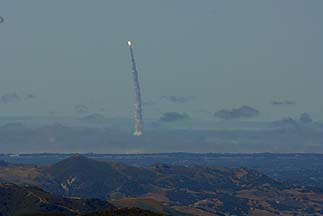 The U.S. Missile Defense Agency STSS-RTRR satellite was launched from Vandenberg Air Force Base on a Delta-II rocket at 1:24:25 PM on May 5.
The U.S. Missile Defense Agency STSS-RTRR satellite was launched from Vandenberg Air Force Base on a Delta-II rocket at 1:24:25 PM on May 5.
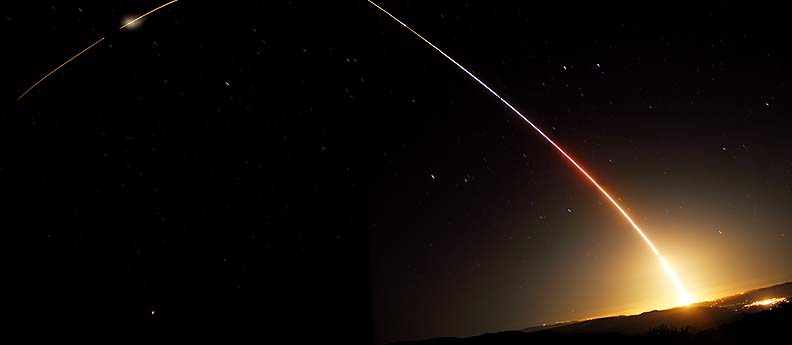 A Taurus booster launched the orbiting Carbon Observatory from SLC-576E Vandenberg Air Force Base at 1:55 AM on Tuesday, February 24, but the payload shroud faiiled to separate. It ascended on a trajectory that arched higher above the horizon, as viewed from from my position, than other orbital launches that I have photographed.
A Taurus booster launched the orbiting Carbon Observatory from SLC-576E Vandenberg Air Force Base at 1:55 AM on Tuesday, February 24, but the payload shroud faiiled to separate. It ascended on a trajectory that arched higher above the horizon, as viewed from from my position, than other orbital launches that I have photographed.
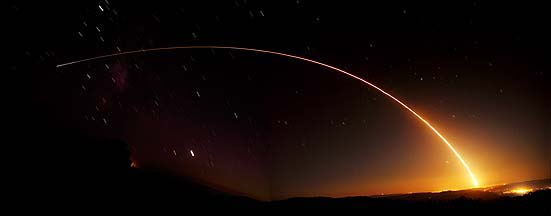 The COSMO-3 satellite was launched into polar orbit on a Delta II rocket from Space Launch Complex 2 at Vandenberg Air Force Base at 7:28 and 12 seconds on the evening of Friday, October 24. In order to place it in the same orbital plane as the first two COSMOS-Skymed satellites, the launch window was only one second long. This time exposure captures the launch from ignition to burn out of the first stage main engine, 4 minutes 36 seconds after launch. The second stage is too faint to register in this image. I used two cameras with 18mm lenses to capture the launch from ignition through burnout of the first stage. The lights of the City of Buellton can be seen on the lower right. The planet Venus is the brightest astronomical object to the left of center. This picture was taken in the Santa Ynez Mountains about 35 miles east of the launch pad.
The COSMO-3 satellite was launched into polar orbit on a Delta II rocket from Space Launch Complex 2 at Vandenberg Air Force Base at 7:28 and 12 seconds on the evening of Friday, October 24. In order to place it in the same orbital plane as the first two COSMOS-Skymed satellites, the launch window was only one second long. This time exposure captures the launch from ignition to burn out of the first stage main engine, 4 minutes 36 seconds after launch. The second stage is too faint to register in this image. I used two cameras with 18mm lenses to capture the launch from ignition through burnout of the first stage. The lights of the City of Buellton can be seen on the lower right. The planet Venus is the brightest astronomical object to the left of center. This picture was taken in the Santa Ynez Mountains about 35 miles east of the launch pad.
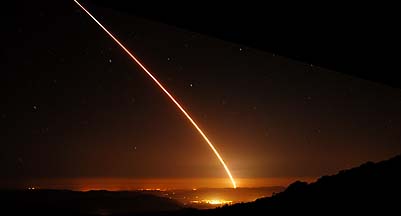 A Target Launch Vehicle, a modified Minuteman ICBM, was launched from Vandenberg Air Force Base at midnight on September 24, 2008 as the Near Field Infrared Experiment (NFIRE) satellite passed overhead off the coast of California. NFIRE imaged the rocket and its plume in infra-red for the Missile Defence Agency.
A Target Launch Vehicle, a modified Minuteman ICBM, was launched from Vandenberg Air Force Base at midnight on September 24, 2008 as the Near Field Infrared Experiment (NFIRE) satellite passed overhead off the coast of California. NFIRE imaged the rocket and its plume in infra-red for the Missile Defence Agency.
 The Geoeye 1 satellite was launched into polar orbit from Vandenberg Air Force Base on a Delta-II booster at 11:50:57 AM on Saturday, September 6, 2008.
The Geoeye 1 satellite was launched into polar orbit from Vandenberg Air Force Base on a Delta-II booster at 11:50:57 AM on Saturday, September 6, 2008.
 The Jason 2 satellite was launched into polar orbit from Vandenberg Air Force Base on a Delta-II rocket at 12:46 A.M. on Friday, June 20.
The Jason 2 satellite was launched into polar orbit from Vandenberg Air Force Base on a Delta-II rocket at 12:46 A.M. on Friday, June 20.
You can buy framed prints or greeting cards of this photo.
A sequence of thirty-second exposures of the Delta-II launch.
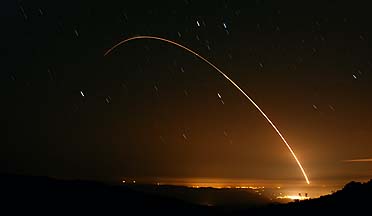 A Minuteman III missile was launched on a suborbital trajectory toward Kwajalein Atoll from Vandenberg Air Force Base at 1:01 A.M. on Wednesday, April 2.
A Minuteman III missile was launched on a suborbital trajectory toward Kwajalein Atoll from Vandenberg Air Force Base at 1:01 A.M. on Wednesday, April 2.
You can buy framed prints or greeting cards of this photograph.
 The second Italian COSMO-SkyMed mission was launched on a Delta-II booster at 6:31 PM PST on Saturday, December 8, 2007.
The second Italian COSMO-SkyMed mission was launched on a Delta-II booster at 6:31 PM PST on Saturday, December 8, 2007.
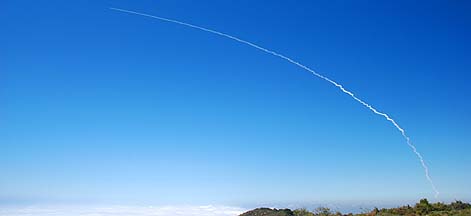 The Worldview-1 satellite was launched from Space Launch Complex 2 at Vandenberg Air Force Base on a Delta-II rocket at 11:35 AM PDT on September 18, 2007.
The Worldview-1 satellite was launched from Space Launch Complex 2 at Vandenberg Air Force Base on a Delta-II rocket at 11:35 AM PDT on September 18, 2007.
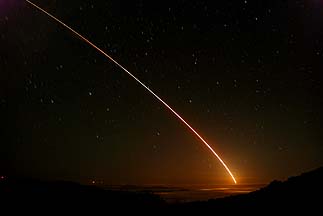 A Minotaur rocket was launched from LF-06 at Vandenberg Air Force Base at 1:31 Am on Thursday, August 23, 2007.
A Minotaur rocket was launched from LF-06 at Vandenberg Air Force Base at 1:31 Am on Thursday, August 23, 2007.
You can buy framed prints or greeting cards of this photograph.
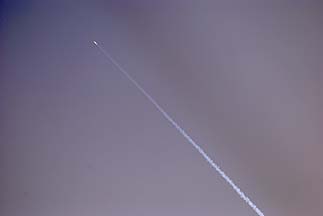 The Italian COSMO-SkyMed mission was launched on a Delta-II booster at 7:34 PM PDT, the end of its thirteen minute launch window. The exhaust trail from the ascending rocket cast a shadow across the sky.
The Italian COSMO-SkyMed mission was launched on a Delta-II booster at 7:34 PM PDT, the end of its thirteen minute launch window. The exhaust trail from the ascending rocket cast a shadow across the sky.
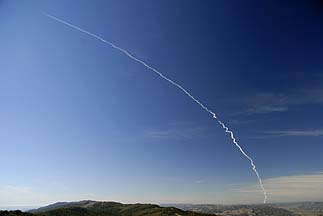 A classified National Reconnaissance Office satellite was launched into orbit from Space Launch Complex 2 West at Vandenberg Air Force Base by a Delta-II rocket at 1:00 PM PST Thursday, December 14. I will post more pictures shortly.
A classified National Reconnaissance Office satellite was launched into orbit from Space Launch Complex 2 West at Vandenberg Air Force Base by a Delta-II rocket at 1:00 PM PST Thursday, December 14. I will post more pictures shortly.
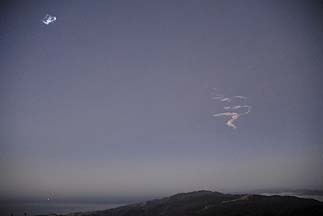 The Defense Meteorological Satellite Program (DMSP) F-17 Block 5D-3 spacecraft was lofted into orbit from Space Launch Complex 6 (SLC-6, pronounced slick six) by a Delta-IV rocket shortly before dawn, at 5:53 AM PST on Saturday, November 4, 2006.
The Defense Meteorological Satellite Program (DMSP) F-17 Block 5D-3 spacecraft was lofted into orbit from Space Launch Complex 6 (SLC-6, pronounced slick six) by a Delta-IV rocket shortly before dawn, at 5:53 AM PST on Saturday, November 4, 2006.
 The first Boeing Delta-IV rocket to be launched from Vandenberg Air Force Base lifted off at 8:33 P.M. PDT Tuesday, June 27. The launch was postponed to the end of the 19 minute launch window due to winds at the launch pad.
The first Boeing Delta-IV rocket to be launched from Vandenberg Air Force Base lifted off at 8:33 P.M. PDT Tuesday, June 27. The launch was postponed to the end of the 19 minute launch window due to winds at the launch pad.
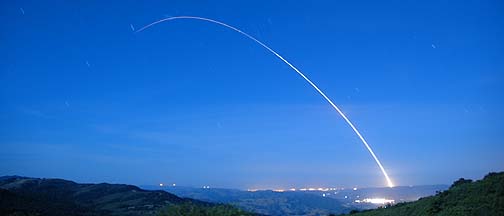 A Minuteman III missile was launched on a suborbital trajectory toward Kwajalein Atoll from LF-04 at Vandenberg Air Force Base at 1:22 A.M. on Wednesday, June 14. A nearly full moon illuminated the landscape during this 3-minute 10-second exposure.
A Minuteman III missile was launched on a suborbital trajectory toward Kwajalein Atoll from LF-04 at Vandenberg Air Force Base at 1:22 A.M. on Wednesday, June 14. A nearly full moon illuminated the landscape during this 3-minute 10-second exposure.
 The Cloudsat and CALIPSO satellites were launched into orbit by a Delta-II rocket at 3:02:16 AM PDT Friday April 28.
The Cloudsat and CALIPSO satellites were launched into orbit by a Delta-II rocket at 3:02:16 AM PDT Friday April 28.
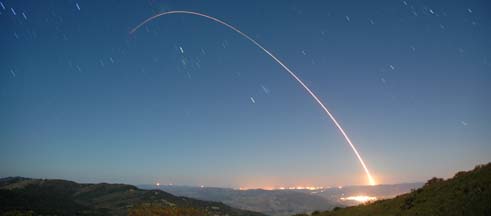 A Minuteman III missile was launched on a suborbital trajectory toward Kwajalein Atoll from LF-10 at Vandenberg Air Force Base at 12:01 A.M. on Thursday, February 16. The ascent of the missile was monitored by a crew aboard HALO II, a modified Gulfstream IIB with a large infra-red telescope.
A Minuteman III missile was launched on a suborbital trajectory toward Kwajalein Atoll from LF-10 at Vandenberg Air Force Base at 12:01 A.M. on Thursday, February 16. The ascent of the missile was monitored by a crew aboard HALO II, a modified Gulfstream IIB with a large infra-red telescope.
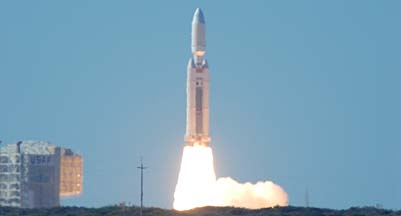 The last Lockheed-Martin Titan IVB rocket launched a classified National Reconnaissance Office payload into orbit from Space Launch Complex 4-East at Vandenberg Air Force Base at 11:05 A.M. Thursday morning. Future large payloads will be launched from Space Launch Complex 6 on the Boeing Delta IV Heavy.
The last Lockheed-Martin Titan IVB rocket launched a classified National Reconnaissance Office payload into orbit from Space Launch Complex 4-East at Vandenberg Air Force Base at 11:05 A.M. Thursday morning. Future large payloads will be launched from Space Launch Complex 6 on the Boeing Delta IV Heavy.
 The Air Force STP-R1 Streak satellite was launched into polar orbit by a Minotaur rocket from Space launch Complex 8 at Vandenberg Air Force Base at 7:24 P.M. PDT on Thursday, September 22, 2005. The rocket climbed in to sunlight about 70 seconds after ignition of its first stage.
The Air Force STP-R1 Streak satellite was launched into polar orbit by a Minotaur rocket from Space launch Complex 8 at Vandenberg Air Force Base at 7:24 P.M. PDT on Thursday, September 22, 2005. The rocket climbed in to sunlight about 70 seconds after ignition of its first stage.
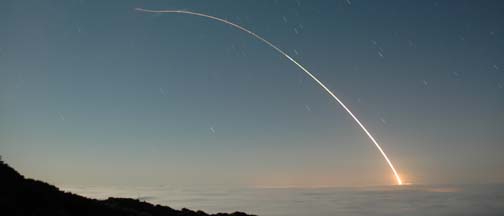 A Minuteman III missile was launched on a suborbital trajectory toward Kwajalein Atoll from Vandenberg Air Force Base at 1:01 A.M. on Wednesday, September 14. The launch was triggered by an Air Force launch team aboard a Boeing E-6 Mercury. The ascent of the missile was monitored by a crew aboard HALO II, a modified Gulfstream IIB with a large infra-red telescope.
A Minuteman III missile was launched on a suborbital trajectory toward Kwajalein Atoll from Vandenberg Air Force Base at 1:01 A.M. on Wednesday, September 14. The launch was triggered by an Air Force launch team aboard a Boeing E-6 Mercury. The ascent of the missile was monitored by a crew aboard HALO II, a modified Gulfstream IIB with a large infra-red telescope.
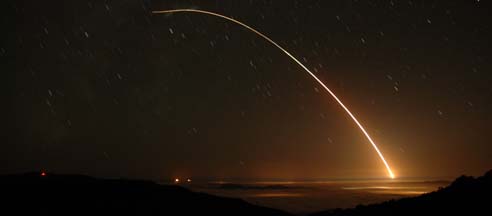 A Minuteman III missile was launched on a suborbital trajectory toward Kwajalein Atoll from Vandenberg Air Force Base at 1:53 A.M. on Wednesday, September 7.
A Minuteman III missile was launched on a suborbital trajectory toward Kwajalein Atoll from Vandenberg Air Force Base at 1:53 A.M. on Wednesday, September 7.
 A Minuteman III missile was launched on a suborbital trajectory toward Kwajalein Atoll from Vandenberg Air Force Base at 1:01 A.M. on Thursday, August 25.
A Minuteman III missile was launched on a suborbital trajectory toward Kwajalein Atoll from Vandenberg Air Force Base at 1:01 A.M. on Thursday, August 25.
 A Minuteman III missile was launched on a suborbital trajectory toward Kwajalein Atoll from Vandenberg Air Force Base at 1:01 A.M. on Thursday, July 21. The full moon illuminated the landscape and clouds during the 198-scond exposure.
A Minuteman III missile was launched on a suborbital trajectory toward Kwajalein Atoll from Vandenberg Air Force Base at 1:01 A.M. on Thursday, July 21. The full moon illuminated the landscape and clouds during the 198-scond exposure.
 The NOAA-18 satellite was launched from Space Launch Complex 2W at Vandenberg Air Force Base on a Delta II booster at 3:22 A.M. PDT, Friday May 20. The Santa Ynez Valley was shrouded in fog and the waxing gibbous moon was hanging over the western horizon. NOAA-18 will replace NOAA-16 later this summer.
The NOAA-18 satellite was launched from Space Launch Complex 2W at Vandenberg Air Force Base on a Delta II booster at 3:22 A.M. PDT, Friday May 20. The Santa Ynez Valley was shrouded in fog and the waxing gibbous moon was hanging over the western horizon. NOAA-18 will replace NOAA-16 later this summer.
 The Air Force Research Laboratory launched its Experimental Satellite System-11 (XSS-11) satellite from Space Launch Complex 8 at Vendenberg Air Force Base at 6.35 A.M. PDT on April 11, 2005. The launch vehicle was a Minotaur, a rocket that is part Minuteman and part Orbital Sciences' Pegasus. The micro-satellite is intended to demonstrate autonomous inspection; rendezvous and docking; repositioning; and techniques for maneuvering around other satellites.
The Air Force Research Laboratory launched its Experimental Satellite System-11 (XSS-11) satellite from Space Launch Complex 8 at Vendenberg Air Force Base at 6.35 A.M. PDT on April 11, 2005. The launch vehicle was a Minotaur, a rocket that is part Minuteman and part Orbital Sciences' Pegasus. The micro-satellite is intended to demonstrate autonomous inspection; rendezvous and docking; repositioning; and techniques for maneuvering around other satellites.
The Minotaur launch vehicle reached the desired orbit about 12 minutes after launch. The XSS-11 micro-satellite separated successfully from the booster and is functioning properly.
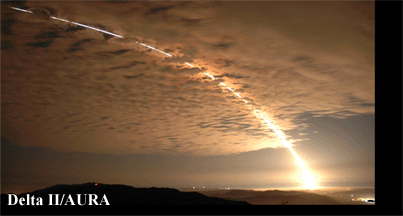 This animated .GIF
illustrates the different launch trajectories of the Delta-II, Peacekeeper, and
Minuteman III.
This animated .GIF
illustrates the different launch trajectories of the Delta-II, Peacekeeper, and
Minuteman III.
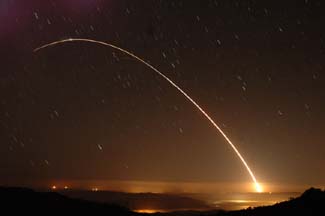 A Minuteman III missile was launched from Vandenberg Air Force Base to the
Reagan Test Range at Kwajalein Atoll very shortly after the beginning of the
launch window at 1:01 A.M. on Wednesday, September 15.
A Minuteman III missile was launched from Vandenberg Air Force Base to the
Reagan Test Range at Kwajalein Atoll very shortly after the beginning of the
launch window at 1:01 A.M. on Wednesday, September 15.
 A Minuteman
III missile was launched on a suborbital trajectory
toward Kwajalein Atoll from
Vandenberg Air Force Base at 1:37 A.M. on Friday, July 23.
A Minuteman
III missile was launched on a suborbital trajectory
toward Kwajalein Atoll from
Vandenberg Air Force Base at 1:37 A.M. on Friday, July 23.
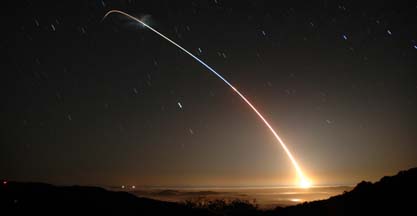 An LGM-118A Peacekeeper missile was launched on a suborbital trajectory
toward Kwajalein Atoll from
Vandenberg Air Force Base at 1:01 A.M. on Wednesday, July 21.
An LGM-118A Peacekeeper missile was launched on a suborbital trajectory
toward Kwajalein Atoll from
Vandenberg Air Force Base at 1:01 A.M. on Wednesday, July 21.
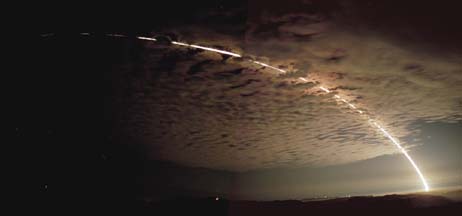 NASA's AURA satellite was
launched from
Vandenberg AFB on a Delta II booster at 3:02 A.M on
Thursday, July 15.
NASA's AURA satellite was
launched from
Vandenberg AFB on a Delta II booster at 3:02 A.M on
Thursday, July 15.
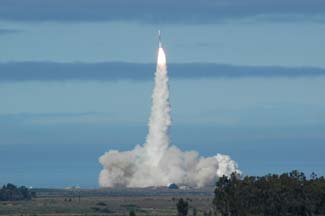 The Gravity-B probe was launched from Vandenberg Air Force Base on
April 20, 2004. It will verify whether the
magnitude of warping of the space-time continuum caused by the rotation of the
Earth is properly predicted by Einstein's General Thoery of Relativity.
The Gravity-B probe was launched from Vandenberg Air Force Base on
April 20, 2004. It will verify whether the
magnitude of warping of the space-time continuum caused by the rotation of the
Earth is properly predicted by Einstein's General Thoery of Relativity.
The last Atlas II launch from Vandenberg Air Force Base was conducted at 2:04 in the morning on Tuesday, December 2. It carried a classified National Reconnaissance Office payload into polar orbit.
The slightly gibbous moon was setting in a clear sky while I drove to Lompoc in the early morning. It pointed straight down. Its light was reflected in the Santa Barbara Channel. A Highway Patrol car blocked the entrance to Jalama Beach Road, which was a good sign that preparations for the launch were still underway.
I arrived at a turnout in the hills north of Lompoc at 1:45 A.M., a little more than fifteen minutes before the launch. The lights of Lompoc illuminated a thin layer of medium-altitude clouds.
Powerful spotlights were directed at the Atlas IIAS rocket on the launch pad at Space Launch Complex 3 East, about 8 miles away. The shafts of light pointed over Lompoc and down the Santa Ynez Valley.
The thin layer of clouds grew noticeably thicker in the minutes before the launch.
Shortly before T-minus-zero two brief flashes of light accompanied the ignition of the liquid fueled first stage. Right at zero the entire valley was suddenly illuminated by the brilliant glow of the four solid fuel boosters. At first the rocket rose slowly toward the cloud deck. It lit up the Lompoc Valley like an arc welder.
The rocket's flame cast bright circle of light on the bottom of the cloud deck. The circle of light grew larger as the rocket neared the clouds. The rocket pierced the clouds, which swallowed up its light. The circle of light on the base of the clouds shrank again as the Atlas raced upward.
The long, bright yellow flame appeared through a few gaps in the clouds as the first sound of the launch reached my position. Nothing beats a solid fuel rocket for basso profundo! Whammety bammety! Pow! Pow! Pow! Nobody remained asleep in Lompoc at 2:05 in the morning.
Another very high altitude cloud layer glowed brighter as the Atlas ascended toward it. The rocket's yellow flame dimmed and turned orange as the solid fuel boosters burned out. The liquid fueled core of the rocket was only dimly visible through the clouds as the sound of the rocket climbed into the sky behind it, gradually fading away like distant thunder.
Note the difference in the appearance of the photo made with negative film and the one made with positive film. The overexposed area on the positive film lacks detail where the film has become nearly transparent. There is still detail in the overexposed area on the negative film where the image is densest.
A task force from the 91st Space Wing, Minot AFB, N.D., launched an unarmed Minuteman III intercontinental ballistic missile from North Vandenberg as part of a flight test for Air Force Space Command's Force Development Evaluation Program at 4:31 a.m. Wednesday, September 10, 2003.
I was on the road just after 3:30 in the morning. The moon was completely full and close to Mars in the sky. Fog was streaming through the mountain passes from the Santa Ynez Valley.
The Santa Ynez Valley was obscured by clouds. I could not see the lights of the towns below, which made it difficult to orient myself. The sky overhead was mostly clear. The bright moonlight illuminated the landscape but did not provide any color. Mars was a bright red dot a short distance from the moon.
I pulled out a Nikon FE with a 28mm lens, put it on a tripod and attached a locking cable release. I pointed it in the direction of the Minuteman launch silos on Vandenberg AFB and locked open the shutter for a time exposure, just in case the launch happened when I wasn't looking.
I pulled out a second Nikon FE with a 28mm lens, put it on a tripod and attached a locking cable release. I pointed it in the direction of the Minuteman launch silos on Vandenberg AFB, but I did not begin an exposure. I planned to open the shutter on that camera when I saw the first light of the rocket launch.
I grabbed a coffee mug and a chair to wait for the launch. I hadn't quite unfolded the chair when I saw the light from the ignition of the Minuteman III shining through the fog deck.
I dropped the chair and moved to open the shutter on the second camera.
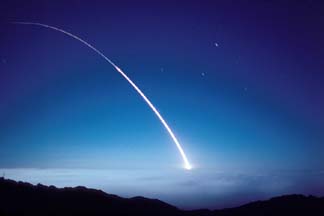 The brilliant yellow flame of the first stage
rose slowly out of the mist and climbed in the direction of the
moon. The flame accelerated and grew longer as it
ascended. The star Deneb and other stars of the constellation
Cygnus can be seen in the right half of the frame.
The brilliant yellow flame of the first stage
rose slowly out of the mist and climbed in the direction of the
moon. The flame accelerated and grew longer as it
ascended. The star Deneb and other stars of the constellation
Cygnus can be seen in the right half of the frame.
 The first camera had already recorded a long
time exposure of the moonlit landscape, long enough to
overexpose the clouds in the valley. Note the longer star
trails.
The first camera had already recorded a long
time exposure of the moonlit landscape, long enough to
overexpose the clouds in the valley. Note the longer star
trails.
The flare of the ignition of the second stage was easy to recognize. The first stage could be seen tumbling, a flashing orange dot that grew dimmer and fell behind the ascending rocket. The rocket's flame flared a bit brighter several times as the Minuteman arced over toward the west. The first stage left a contrail that was dimly visible in the moonlight.
The apparent motion of the Minuteman slowed as it headed nearly directly away, toward Kwajalein Atoll. The light of the last stage dimmed while the rocket was still high above the western horizon. A short while later, the rumble of the rocket engine reached my shooting location. A deep booming resounded from overhead for several seconds.
The clock in the car read 4:38 when I turned on the ignition. That was the most prompt Minuteman launch I can recall.
As I rounded a corner on the south side of the mountain on the drive back down, I was presented with an expansive view of the clouds pouring through a mountain pass below me, shining brightly under the full moon. Moonlight sparkled on the surface of the water in the channel.
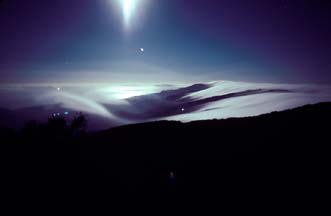 I noticed a cloud phenomenon I had
not observed before. As the fog poured down the slope
toward the shoreline, it started to evaporate. Near
the bottom of the slope the airflow detached from the ground and
lifted over the marine layer. As the air rose higher, puffy
cumulus clouds condensed from the humid air.
I noticed a cloud phenomenon I had
not observed before. As the fog poured down the slope
toward the shoreline, it started to evaporate. Near
the bottom of the slope the airflow detached from the ground and
lifted over the marine layer. As the air rose higher, puffy
cumulus clouds condensed from the humid air.
 An Orbital Sciences Exoatmospheric
Kill Vehicle (EKV) was launched from Vandenberg Air Force Base at
11:00 A.M. on Saturday August 16, 2003. The bright flame of the
rocket engine climbed out of the marine layer haze right at the
beginning of the launch window.
An Orbital Sciences Exoatmospheric
Kill Vehicle (EKV) was launched from Vandenberg Air Force Base at
11:00 A.M. on Saturday August 16, 2003. The bright flame of the
rocket engine climbed out of the marine layer haze right at the
beginning of the launch window.
 It appeared to rise from the north
end of the base, where the old Minuteman silos are located. It
ascended on a completely different trajectory than I have
photographed before. It accelerated very quickly and didn't arc
over at all. It just headed up and slightly toward the south.
It appeared to rise from the north
end of the base, where the old Minuteman silos are located. It
ascended on a completely different trajectory than I have
photographed before. It accelerated very quickly and didn't arc
over at all. It just headed up and slightly toward the south.
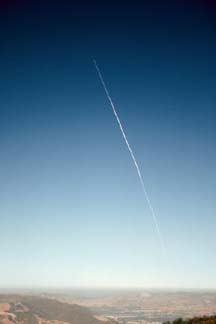 The transition to the second stage
was clearly visible as the exhaust trail suddenly grew fainter.
The transition to the second stage
was clearly visible as the exhaust trail suddenly grew fainter.
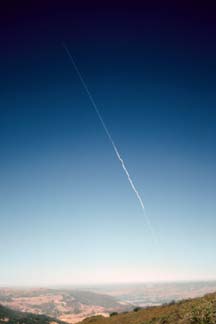 The upper stages left no trail, but
the rocket's flame and its expanding plume were visible against
the dark sky. It burned out much higher in the sky than any other
launch I have seen.
The upper stages left no trail, but
the rocket's flame and its expanding plume were visible against
the dark sky. It burned out much higher in the sky than any other
launch I have seen.
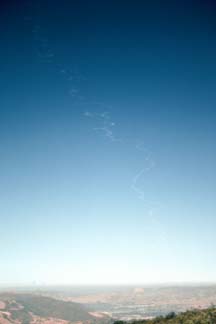 A few minutes after burnout, the
sound of the ascending rocket reached my position in the Santa
Ynez Mountains north of Santa Barbara. It was a faint rumble from
high in the sky.
A few minutes after burnout, the
sound of the ascending rocket reached my position in the Santa
Ynez Mountains north of Santa Barbara. It was a faint rumble from
high in the sky.
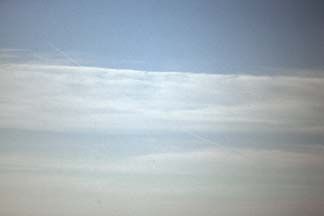 The Canadian Space Agency's SCISAT-1 (Scientific Satellite Atmospheric
Chemistry Experiment) was launched at 7:09:33 P.M. on August 12.
The launch trail appeared through the gap below the top layer of
clouds right at 7:10.
The Canadian Space Agency's SCISAT-1 (Scientific Satellite Atmospheric
Chemistry Experiment) was launched at 7:09:33 P.M. on August 12.
The launch trail appeared through the gap below the top layer of
clouds right at 7:10.
 The rocket passed directly in front of the sun.
The upper stages left almost no exhaust trail. Just the flame of
the rocket was visible, ascending toward the southern sky.
The rocket passed directly in front of the sun.
The upper stages left almost no exhaust trail. Just the flame of
the rocket was visible, ascending toward the southern sky.
I set the alarm for 4:50 A.M. for the second day in a row on the morning of January 6 so I could drive to a good photography location for the launch of the Coriolis mission on a Titan II. The Coriolis mission is composed of Windsat and the Solar Mass Ejection Imager (SMEI).
The previous morning I had driven up to Harris Grade Road, north of Lompoc to photograph the launch, but it was scrubbed because high altitude winds might have carried debris into populated areas if it became necessary to destroy the rocket.
It was still dark as I drove out Highway 1 to Lompoc for the second launch attempt. I could see the floodlights at SLC-4W shining into the sky over the mountains. The earliest morning comuters from Lompoc were already driving toward Santa Barbara.
I drove around Lompoc and up the Harris Grade Road. A deer crossed the road in front of me. I slowed down and then had to brake hard to miss the second deer that trotted across the road. There were a few cars parked in the turnouts near the crest of the grade.
I parked on an empty turnout. The air was still and the temperature must have been in the sixties. It was very comfortable without a jacket or hat. I called the VAFB launch hotline (805 606-1857), but the launch announcement had not been updated. At least the launch hadn't been scrubbed yet.
I put a 28mm lens on one camera and my 400 mm telephoto on the other one. I could see the Titan II brightly illuminated on the launch pad about 8 miles away.
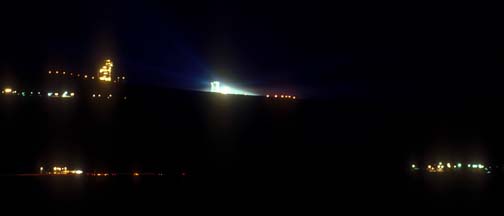 I took one picture through the
telephoto, then set both shutters to B to shoot time exposures. I
tuned the scanner to the range control frequency. It provided
regular call outs of the time to launch. I listened as range
control polled the various systems officers, each calling out
"GO!" in turn. Finally, range control announced
"Titan is GO!", five minutes before launch.
I took one picture through the
telephoto, then set both shutters to B to shoot time exposures. I
tuned the scanner to the range control frequency. It provided
regular call outs of the time to launch. I listened as range
control polled the various systems officers, each calling out
"GO!" in turn. Finally, range control announced
"Titan is GO!", five minutes before launch.
I grabbed the cable releases as range control counted down the last several seconds to launch. At T-1, I locked the shutters of both cameras open.
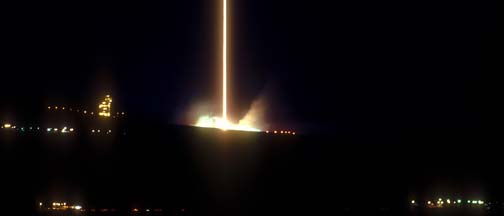 The sky was still dark as the
brilliant flame appeared over the launch pad and at first it
climbed relatively slowly for a rocket. After the Titan II
cleared the pad, I closed the shutter on the telephoto.
The sky was still dark as the
brilliant flame appeared over the launch pad and at first it
climbed relatively slowly for a rocket. After the Titan II
cleared the pad, I closed the shutter on the telephoto.
The liquid fueled engines did not leave a visible trail until the rocket was a few miles up. The contrail started as a long straight line in the sky that quickly twisted into a zig-zag as the Titan continued its ascent.
The separation of the first stage and ignition of the second stage were clearly visible. A small puff of smoke remained suspended at the location where the staging had occurred.
As the upper stage arced over to the southern horizon, the discarded stages became visible trailing behind it. First there were two small lights trailing vapor, then a couple more, and finally there were five or six separate components. Each piece flashed periodically, leaving a trail of dots on the time exposure. It seemed as if there were too many pieces for a Titan II The trailing components may have been panels from the payload fairing.
 The sky was brightening noticeably
as the light from the rocket pieces faded and I closed the
shutter on the wide angle. Note the cloud of condensed combustion
products drifting in the high altitude breeze. This photo
appears in the Gallery section of the May 2003 issue of Sky and
Telescope Magazine.
The sky was brightening noticeably
as the light from the rocket pieces faded and I closed the
shutter on the wide angle. Note the cloud of condensed combustion
products drifting in the high altitude breeze. This photo
appears in the Gallery section of the May 2003 issue of Sky and
Telescope Magazine.
Link to the U. S. Air Force fact sheet for the Titan II.
Link to the NRL Windsat home page.
Link to the University of Birmingham (SMEI) page.
 A Minuteman II was launched from
Vandenberg Air Force Base at 7:01 PM on October 14, 2002 in
support of the Missile Defense Agency's Ground-Based Midcourse
Defense Program. It produced a vivid sunset effect.
A Minuteman II was launched from
Vandenberg Air Force Base at 7:01 PM on October 14, 2002 in
support of the Missile Defense Agency's Ground-Based Midcourse
Defense Program. It produced a vivid sunset effect.
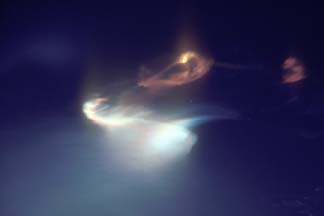 The exhaust trail shape-shifted
until the shadow of the earth extinguished its light source.
The exhaust trail shape-shifted
until the shadow of the earth extinguished its light source.
Link to the Midcourse Defense Segment page of the Missile Defense Agency
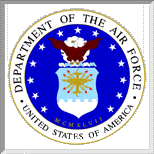 Link to the U. S. Air Force Minuteman III Fact Sheet.
Link to the U. S. Air Force Minuteman III Fact Sheet.
 Link to the Minuteman III Page of the Federation of
American Scientists.
Link to the Minuteman III Page of the Federation of
American Scientists.
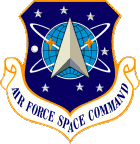 Link to the Minuteman III Page of the United
States Space Command.
Link to the Minuteman III Page of the United
States Space Command.
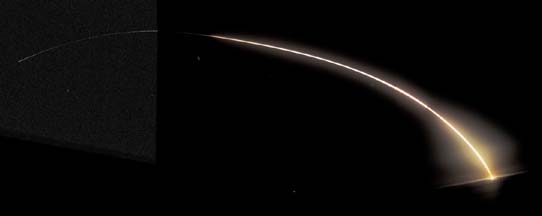 The AQUA spacecraft, part of NASA's
Earth Observing System (EOS), was launched from Space Launch
Complex 2 at Vandenberg Air Force Base by a Delta-II at 2:54 A.M.
on May 4, 2002. This is a three frame composite time exposure
taken from the crest of the Santa Ynez Mountains about 35 miles
from the launch pad.
The AQUA spacecraft, part of NASA's
Earth Observing System (EOS), was launched from Space Launch
Complex 2 at Vandenberg Air Force Base by a Delta-II at 2:54 A.M.
on May 4, 2002. This is a three frame composite time exposure
taken from the crest of the Santa Ynez Mountains about 35 miles
from the launch pad.
Visit the Aqua Spacecraft web site.
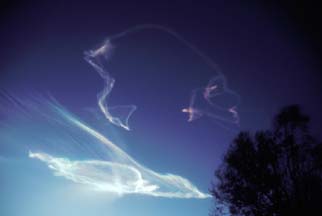 A modified Minuteman II was
launched from Vandenberg AFB at 6:15 PST on March 15, 2002 as
part of the Orbital/Suborbital Program (OSP). Its exhaust trail
was illuminated by the sun for a long while after sunset.
A modified Minuteman II was
launched from Vandenberg AFB at 6:15 PST on March 15, 2002 as
part of the Orbital/Suborbital Program (OSP). Its exhaust trail
was illuminated by the sun for a long while after sunset.
According to a Vandenberg press release, "The OSP, a modified Minuteman II intercontinental ballistic missile, carried a mock warhead and three balloon decoys. At about 6:36 p.m. PST, and about 4,800 miles away, a Payload Launch Vehicle missile carrying a prototype exoatmospheric kill vehicle (EKV) interceptor launched from the Ronald Reagan Missile Test Site at Kwajalein Atoll in the Republic of the Marshall Islands. At about 6:45 p.m. PST, the intercept took place at an altitude of approximately 140 miles above the central Pacific Ocean during the midcourse phase of the target warhead’s flight."
 The bright colors are the result of
sunlight refracting through crystals of solidified exhaust
products.
The bright colors are the result of
sunlight refracting through crystals of solidified exhaust
products.
 A Boeing-McDonnell-Douglas Delta-II launched the
another constellation of Iridium satellites from Vandenberg AFB
at 9:44 A.M. P.S.T. on February 11, 2002.
A Boeing-McDonnell-Douglas Delta-II launched the
another constellation of Iridium satellites from Vandenberg AFB
at 9:44 A.M. P.S.T. on February 11, 2002.
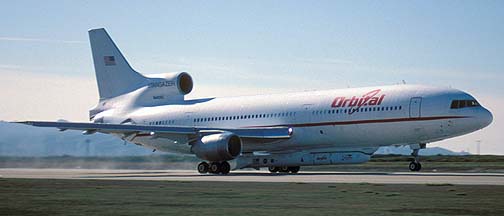 The Orbital Sciences Corporation
L-1011, Stargazer, carried the High Energy Solar
Spectroscopic Imager (HESSI) spacecraft from Vandenberg Air
Force Base, California to the Kennedy Space Center in Florida on
Friday February 1.
The Orbital Sciences Corporation
L-1011, Stargazer, carried the High Energy Solar
Spectroscopic Imager (HESSI) spacecraft from Vandenberg Air
Force Base, California to the Kennedy Space Center in Florida on
Friday February 1.
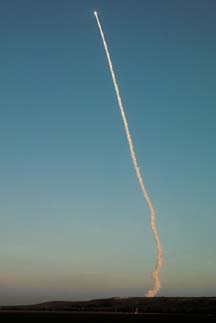 A Boeing-McDonnell-Douglas Delta-II launched the
Jason and TIMED satellites from Vandenberg AFB at 7:07 A.M.
P.S.T. on December 7, 2001.
A Boeing-McDonnell-Douglas Delta-II launched the
Jason and TIMED satellites from Vandenberg AFB at 7:07 A.M.
P.S.T. on December 7, 2001.
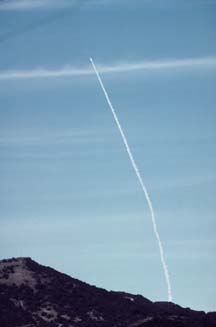 The Digital Globe Quickbird II
satellite was launched on a Delta-II-7320-10 at 11:51 on the
morning of October 18, 2001.
The Digital Globe Quickbird II
satellite was launched on a Delta-II-7320-10 at 11:51 on the
morning of October 18, 2001.
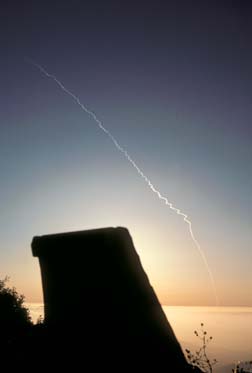 A Minuteman-II
was launched at 7:40 P.M. PDT on Saturday, July 14, 2001.
A Minuteman-II
was launched at 7:40 P.M. PDT on Saturday, July 14, 2001.
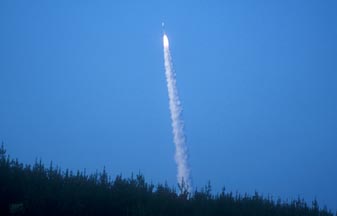 A Boeing Delta II rocket carrying
NASA’s Earth Observing 1 satellite and the Argentine
Commission on Space Activities satellite, SAC-C, was launched
Tuesday, November 21 at 10:24 a.m. PST from Space Launch Complex-2.
It is seen here from Harris Grade Road, ten miles to the east of
the launch pad.
A Boeing Delta II rocket carrying
NASA’s Earth Observing 1 satellite and the Argentine
Commission on Space Activities satellite, SAC-C, was launched
Tuesday, November 21 at 10:24 a.m. PST from Space Launch Complex-2.
It is seen here from Harris Grade Road, ten miles to the east of
the launch pad.
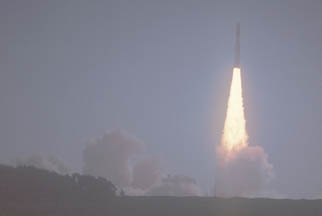 A Titan IVB was launched from Space Launch Complex 4 at 3:45 PM
on Thursday, August 17.
A Titan IVB was launched from Space Launch Complex 4 at 3:45 PM
on Thursday, August 17.
 A Minuteman II missile was launched on a suborbital trajectory from Vandenberg Air Force Base to Kwajalien Atoll on January 18, 2000.
A Minuteman II missile was launched on a suborbital trajectory from Vandenberg Air Force Base to Kwajalien Atoll on January 18, 2000.
 An Atlas-IIAS carrying the Terra Satellite lifted off
at 10:57 A.M. PST on Saturday December 18, 1999 from Space Launch
Complex 3 East.
An Atlas-IIAS carrying the Terra Satellite lifted off
at 10:57 A.M. PST on Saturday December 18, 1999 from Space Launch
Complex 3 East.
 A Defense
Department Meteorological Satellite was launched on a
refurbished Titan II ICBM from SLC-4West at Vandenberg AFB at
9:38 A.M. on December 12, 1999. The top of the SLC-3W gantry can
be seen at left. A row of Eucalyptus trees has been planted to
obscure the view of the launch pads.
A Defense
Department Meteorological Satellite was launched on a
refurbished Titan II ICBM from SLC-4West at Vandenberg AFB at
9:38 A.M. on December 12, 1999. The top of the SLC-3W gantry can
be seen at left. A row of Eucalyptus trees has been planted to
obscure the view of the launch pads.
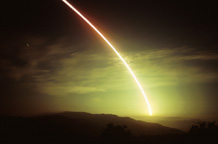 The first launch of a Titan IVB rocket from the
west coast was conducted at 2:36 A.M. on the morning of May 22.
This photo shows the Titan rising from Space Launch Complex 4
East. According to Aviation Week & Space Technology Magazine,
the Titan placed a single large National Reconnaissance
Organization satellite into orbit. The launch utilized a 50-foot long payload fairing, rather than the 56-foot and 66-foot long fairings of previous Air Force Titan IV launches. Four Titan IVB rockets have
already been launched from the Kennedy Space Center in Florida.
The first launch of a Titan IVB rocket from the
west coast was conducted at 2:36 A.M. on the morning of May 22.
This photo shows the Titan rising from Space Launch Complex 4
East. According to Aviation Week & Space Technology Magazine,
the Titan placed a single large National Reconnaissance
Organization satellite into orbit. The launch utilized a 50-foot long payload fairing, rather than the 56-foot and 66-foot long fairings of previous Air Force Titan IV launches. Four Titan IVB rockets have
already been launched from the Kennedy Space Center in Florida.
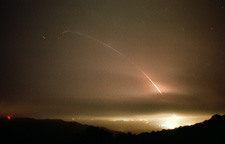 An LGM-118A Peacekeeper missile was launched at
12:01 on the morning of March 10, 1999. In the foreground is the
Santa Ynez Valley, obscured by clouds. The launch was conducted
as part of the Follow-on Operational Test and Evaluation Program
used to obtain information about the missile's accuracy and
reliability. The missile lofted eight unarmed re-entry vehicles
4,200 miles to the Kwajalein Missile Range. It was selected at
random from the missiles of F.E. Warren Air Force Base, Wyoming.
Photographer: Brian Lockett.
An LGM-118A Peacekeeper missile was launched at
12:01 on the morning of March 10, 1999. In the foreground is the
Santa Ynez Valley, obscured by clouds. The launch was conducted
as part of the Follow-on Operational Test and Evaluation Program
used to obtain information about the missile's accuracy and
reliability. The missile lofted eight unarmed re-entry vehicles
4,200 miles to the Kwajalein Missile Range. It was selected at
random from the missiles of F.E. Warren Air Force Base, Wyoming.
Photographer: Brian Lockett.
This exposure was made on Kodak Gold 1000 print film.
 Link to the Peacekeeper Page of the Federation of
American Scientists.
Link to the Peacekeeper Page of the Federation of
American Scientists.
 Link to the Peacekeeper Page of the Air Force Air
University.
Link to the Peacekeeper Page of the Air Force Air
University.
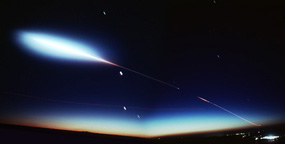 A Pegasus XL rocket was launched from
Stargazer, the Orbital Sciences L-1011, at 6:56 P.M. on March 4,
1999. Its payload was the Wide-field Infra Red Explorer (WIRE)
satellite.
A Pegasus XL rocket was launched from
Stargazer, the Orbital Sciences L-1011, at 6:56 P.M. on March 4,
1999. Its payload was the Wide-field Infra Red Explorer (WIRE)
satellite.
 After twelve aborted launch
attempts, a Delta II was launched at 2:29 A.M. on February 23,
1999 from Space Launch Complex 2. It carried the ARGOS satellite
and two piggyback payloads; The Danish Orsted satellite and the
South African SUNSAT. Photographer: Brian Lockett.
After twelve aborted launch
attempts, a Delta II was launched at 2:29 A.M. on February 23,
1999 from Space Launch Complex 2. It carried the ARGOS satellite
and two piggyback payloads; The Danish Orsted satellite and the
South African SUNSAT. Photographer: Brian Lockett.
Most of the aborts were the result of constraints on high altitude winds. If it becomes necessary to destroy the rocket and the winds aloft are blowing onshore too strongly, there is a risk that debris from the rocket might fall on land.
The first launch attempt on January 15 and six following attempts were aborted due to upper level wind constraints and otherwise poor weather. The seventh launch attempt on January 28 was cut short due to "automatic rocket engine safety interrupt". One of the multitude of sensors on the Delta detected a parameter that was outside of its allowable range and the populsion system was shut down. There is a good chance that this failure would have occured whenever the weather allowed the launch to progress to that point.
After three more delays due to upper level wind constraints, the launch attempt on February 13 encountered an electrical problem in the first stage of the booster.
Ten days later all systems were finally go for the Delta and its three satellites. I lost count, but I am pretty sure that I drove up to West Camino Cielo at 2:30 in the morning at least nine times to get this picture.
This image was assembled from three frames of Kodachrome 64. The trail ends where the upper stage of the Delta II disappeared behind a ridge to the south of my shooting position.
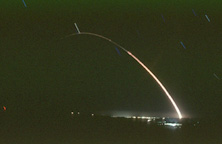 A Minuteman III was launched at 12:06 A.M. on the morning of
February 12, 1999 as part of the Force Development Evaluation
Program. Its suborbital trajectory carried a single unarmed
re-entry vehicle 4,200 miles to Kwajalein Atoll. The Minuteman
III was selected at random from the missiles of the 91st Space
Wing, Minot Air Force Base, N.D.
A Minuteman III was launched at 12:06 A.M. on the morning of
February 12, 1999 as part of the Force Development Evaluation
Program. Its suborbital trajectory carried a single unarmed
re-entry vehicle 4,200 miles to Kwajalein Atoll. The Minuteman
III was selected at random from the missiles of the 91st Space
Wing, Minot Air Force Base, N.D.
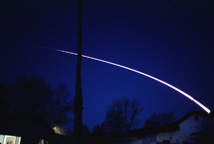 Delta II launch at 5:58 on the morning of
February 18 1998.
Delta II launch at 5:58 on the morning of
February 18 1998.
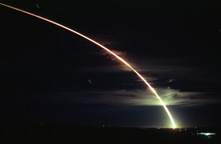 A cluster of Iridium telephone satellites was
launched on a Delta II at 5:16 in the morning on Saturday,
December 20, 1997. I drove up Refugio Road to West Camino Cielo
under a half moon. There is a turnout about 2 miles above the
intersection that provides an overview of the Santa Ynez Valley
and Vandenberg AFB. There was no fog in the valley and the lights
of Buellton and Lompoc shimmered below. There were a few thin
layers of high clouds over the Pacific.
A cluster of Iridium telephone satellites was
launched on a Delta II at 5:16 in the morning on Saturday,
December 20, 1997. I drove up Refugio Road to West Camino Cielo
under a half moon. There is a turnout about 2 miles above the
intersection that provides an overview of the Santa Ynez Valley
and Vandenberg AFB. There was no fog in the valley and the lights
of Buellton and Lompoc shimmered below. There were a few thin
layers of high clouds over the Pacific.
I arrived just about ten minutes before the launch and set up a pair of cameras with 28mm lenses and locking cable releases as the live version of Bodhisattva played on the cassette in the 4runner. I locked open the shutters of the cameras a couple of minutes before the scheduled launch to get a time exposure of the moonlit scenery. The Steely Dan tape ended just about the time that the light from the ignition of the first six Castor solid fuel boosters snapped on, and the far end of the valley lit up like daylight. An intense spot of light appeared on the clouds directly above the launch pad like a searchlight beam.
The dazzling orange light of the rocket's flame rose slowly straight up from the launch pad toward the clouds. The clouds glowed brighter as the rocket approached their altitude and started arching over to the south. The point of light started to stretch into a yellow line as the Delta accelerated. The first six solid fuel boosters burned out at an altitude of about twenty miles and the light from the rocket dimmed briefly.
The next three Castor boosters flared brightly and it seemed like the rate of acceleration increased perceptibly. A moment later little orange sparks could be seen flaring periodically below and behind the Delta as the six expended boosters tumbled away. They were still falling up to their maximum altitude.
The flame of the Delta continued to grow and took on a blue-white tinge at the top end, trailing into a long yellow-orange flame. The last three Castors burned out and the nature of the flame changed completely. The opaque long yellow flame was replaced by an incandescent blue-white point of light with a trail of transparent glowing blue plasma. Just about then the sound of the launch reached my location, rumbling like like distant, continuous thunder.
The last three Castors could be seen as orange sparks that flared periodically below the still accelerating liquid fueled core of the Delta. As the atmospheric pressure around the Delta decreased, the exhaust plume flared more broadly. When the engines cut off, the flame cut off suddenly, but the exhaust trail continued to glow for several seconds. The apparent source of the thundering sound moved across the sky, following the path taken by the Delta a minute earlier.
The exhaust trail had disappeared by the time that the thunder slowly faded into inaudiblity. I broke down the camera setup and put Close to the Edge into the cassette player for the ride down Refugio Road. A gray fox loped through my headlight beams as I cruised down the winding grade.
As dawn brightened the eastern horizon, the exhaust trail became visible again as a white winding track above orange lit stratus clouds.
The IRIDIUM satellites are part of a planned wireless telecommunications network designed to provide worldwide handheld telephone services. The 66-satellite network is scheduled to be operational in 1998. Thirty IRIDIUM satellites have now been launched from Vandenberg. This launch brings the number of IRIDIUM spacecraft in orbit to 46.
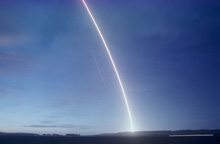 On the afternooon of Saturday November 8, 1997,
I drove out to the fields west of Lompoc to watch the launch of a
Delta II with a cluster of five Motorola Iridium satellites from
Space Launch Complex 2 at Vandenberg AFB. The launch occurred
just long enough after sunset that the Delta climbed into
sunlight about the time that it reached the top of the
atmosphere. This provided a rare opportunity to observe the
exhaust of the rocket against a dark sky, without sunlight
scattered from the intervening atmosphere.
On the afternooon of Saturday November 8, 1997,
I drove out to the fields west of Lompoc to watch the launch of a
Delta II with a cluster of five Motorola Iridium satellites from
Space Launch Complex 2 at Vandenberg AFB. The launch occurred
just long enough after sunset that the Delta climbed into
sunlight about the time that it reached the top of the
atmosphere. This provided a rare opportunity to observe the
exhaust of the rocket against a dark sky, without sunlight
scattered from the intervening atmosphere.
 A Titan IV rocket launched (according to
Aviation Week) a Boeing manufactured reconnaissance satellite,
designed and built by the National Reconnaissance Office, into
polar orbit from Space Launch Complex 4 East on south Vandenberg
at 7:32 p.m, on Thursday October 23, 1997. This photograph was
taken from Goleta. Note how the path of the rocket appears more
vertical than the other launches photographed from Goleta. The
Titan could be seen to travel considerably farther east than the
Deltas. Photographer: Brian Lockett.
A Titan IV rocket launched (according to
Aviation Week) a Boeing manufactured reconnaissance satellite,
designed and built by the National Reconnaissance Office, into
polar orbit from Space Launch Complex 4 East on south Vandenberg
at 7:32 p.m, on Thursday October 23, 1997. This photograph was
taken from Goleta. Note how the path of the rocket appears more
vertical than the other launches photographed from Goleta. The
Titan could be seen to travel considerably farther east than the
Deltas. Photographer: Brian Lockett.
A cluster 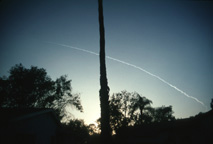 of five Iridium communications satellites was
launched on a Delta at
5:23 P.M. on Friday September 26, 1997 from Vandenberg Air Force
Base.
of five Iridium communications satellites was
launched on a Delta at
5:23 P.M. on Friday September 26, 1997 from Vandenberg Air Force
Base.
The Lewis earth observation satellite  was launched on an Athena (Lockheed-Martin Launch
Vehicle) at 11:51 P.M. on Fruday August 22, 1997 from Vandenberg
Air Force Base. This is a time exposure of the launch. This photo
was shot was from essentially the same place as the Delta launch.
It can be seen that the Athena passed behind the trees that the
Delta rose to the right of. Space Launch Complex 6, from which
the Athena was launched is considerably to the south of the Delta
launch facility. Photographer: Brian Lockett.
was launched on an Athena (Lockheed-Martin Launch
Vehicle) at 11:51 P.M. on Fruday August 22, 1997 from Vandenberg
Air Force Base. This is a time exposure of the launch. This photo
was shot was from essentially the same place as the Delta launch.
It can be seen that the Athena passed behind the trees that the
Delta rose to the right of. Space Launch Complex 6, from which
the Athena was launched is considerably to the south of the Delta
launch facility. Photographer: Brian Lockett.
![]() Link to the Athena Product Page of Lockheed-Martin Astronautics.
Link to the Athena Product Page of Lockheed-Martin Astronautics.
Five Iridium communications satellites were launched on a Delta 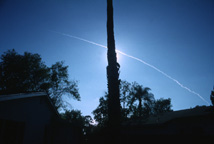 at 5:38 P.M. on Wednesday August
20, 1997 from Vandenberg Air Force Base. It passed nearly
directly in front of the sun from my vantage. Photographer: Brian
Lockett.
at 5:38 P.M. on Wednesday August
20, 1997 from Vandenberg Air Force Base. It passed nearly
directly in front of the sun from my vantage. Photographer: Brian
Lockett.
A converted ICBM Titan II  carrying a DMSP weather satellite was launched
at 8:47 A.M., Friday, April 4, 1997, from SLC-4W at Vandenberg
AFB. The Santa Ynez Valley was clouded over, so I backtracked up
to West Camino Cielo Road near the old Reagan Ranch. The Titan II was already well off the
ground before the contrail became visible. Unlike the solid fuel
boosters of the Titan IV, the liquid fuel engines of the Titan II
produce an almost invisible flame. Photographer: Brian Lockett.
carrying a DMSP weather satellite was launched
at 8:47 A.M., Friday, April 4, 1997, from SLC-4W at Vandenberg
AFB. The Santa Ynez Valley was clouded over, so I backtracked up
to West Camino Cielo Road near the old Reagan Ranch. The Titan II was already well off the
ground before the contrail became visible. Unlike the solid fuel
boosters of the Titan IV, the liquid fuel engines of the Titan II
produce an almost invisible flame. Photographer: Brian Lockett.
 Photographs of rocket and missile launches
from Vandenberg Air Force Base from 1982 to 1996.
Photographs of rocket and missile launches
from Vandenberg Air Force Base from 1982 to 1996.
 Book about
missiles and rockets available from
Book about
missiles and rockets available from 
The Missile and Space Race by Alan J. Levine. Here is a history of the development of military missiles and space travel from World War II to the American visits to the Moon in 1969-1972. It stresses the relationship between the early stages of space exploration and the arms race, and that a dual path led to space flight. One was the development of unmanned long-range war rockets, the other, less often noted, was the rocket-powered research plane. The first path led through the intercontinental ballistic missile to the first artificial satellites and space capsule; the latter, more uniquely American, through the X-series and Skyrocket rocket planes to the X-15, and ultimately to the Space Shuttle. The early part of the book focuses on the Soviet-American race to develop the ICBM in the 1950s, and the first satellites, with particular attention paid to the events and reactions that followed the flight of Sputnik I in 1957 and the subsequent missile gap era.
Link to the home page of the ![]() 30th
Space Wing
30th
Space Wing
Call the Vandenberg Air Force Base Launch Hotline at (805) 606-1857 for current launch schedule information.
The So Cal Sky Lights web site has rocket launches and other sky phenomena.
 Link to the NASA rocket launch manifest
Link to the NASA rocket launch manifest
For national and international space coverage visit SPACE.com
Brian Webb's Rawhide Space Page provides launch schedule and ham radio information.
You can buy a 2020 calendar featuring my photographs of rocket launches from Vandenberg Air Force Base.
Photos of thirteen rocket launches from Vandenberg Air Force Base:
Pegasus-XL/Wide-Field Infra-red Explorer (WIRE) March 4, 1999
Atlas-IIAS/Terra December 18, 1999
Delta II/Gravity Probe B, April 20, 2004
Minotaur/Streak September 22, 2005
Titan IV/National Reconnaissance Office satellite, October 19, 2005
Minuteman III, February 16, 2006
Minuteman III, April 2, 2008
Target Launch Vehicle, September 24, 2008
Delta-II/GeoEye 1, September 6, 2008
Delta II/Jason 2, June 20, 2008
Delta II/COSMO-Skymed, October 24, 2008
Taurus/Orbiting Carbon Observatory, February 24, 2009
Delta-II/Worldview 2, October 28, 2009
 Put a copy of the Rocket Launches from Vandenberg Air Force Base: 2020 Calendar in your Lulu.com shopping cart for $14.95.
Put a copy of the Rocket Launches from Vandenberg Air Force Base: 2020 Calendar in your Lulu.com shopping cart for $14.95.
Books and Videos about Rockets and MIssiles from Amazon.com |
||||
Books |
||||
DVDs |
||||
Visit the Lockett Books Amazon Webstore for a selection of aviation and space related books and DVDs. |
||||
Send a message to Brian.
Go to home page of the Goleta Air and Space Museum.